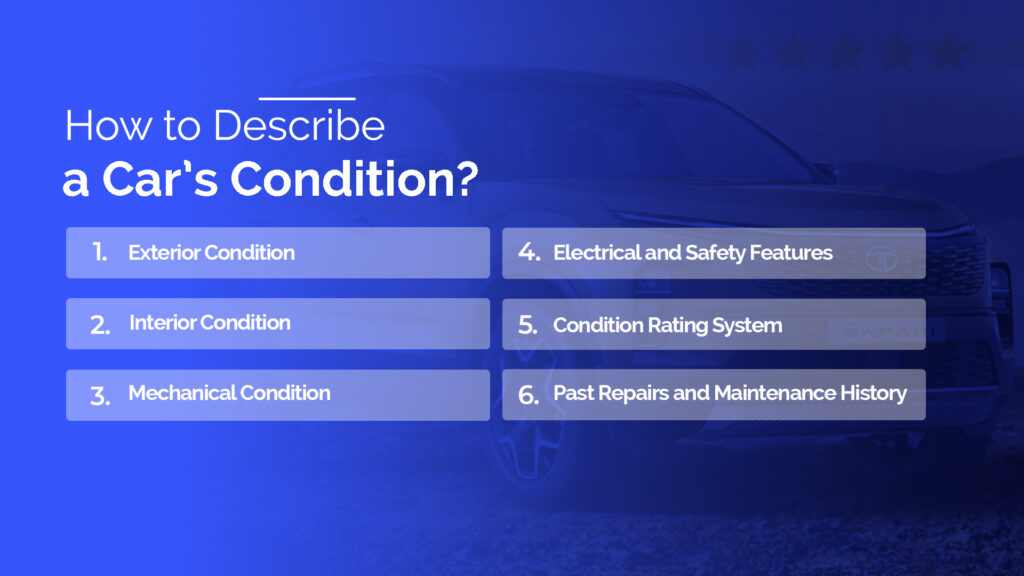A car’s condition is important to car dealerships and online sellers. This is why car condition ratings help with pricing appropriately and let buyers know exactly what they’re getting. Learning about grading systems and condition reports and using these ratings can simplify inventory management and satisfy customers. If you know how to evaluate a car correctly, you can make more informed choices and build trust with your customers. Let’s look in more detail at how these ratings work.
What are Car Condition Ratings?
Car condition ratings describe systems designed to rate a car’s physical and mechanical condition. These ratings are essential for buyers and sellers as they independently assess a car’s quality.
Ratings may be highly divergent depending on the type of vehicle, age, and usage. For instance, classic car ratings use distinct criteria from new model ratings, as assessing an old automobile requires very different considerations.

Significance of Car Condition Ratings
Value Appraisal: Car condition ratings help establish a car’s market value. A higher rating usually means a higher price, while lesser ratings indicate potential problems that may affect value.
Transparency: Dealerships have clear criteria for judging a car’s condition, which reduces misunderstandings between buyers and sellers. In private sales, there are no dealership standards to follow.
Informed Decisions: Prospective buyers can make better choices based on detailed evaluations. Knowing a vehicle’s condition can avoid costly surprises after its purchase.
Car Condition Rating Definitions: Understanding the definitions behind car condition ratings is paramount to interpreting their meanings correctly.
Some of the standard terms used regarding the vehicle condition are:
Meaning of Vehicle Condition: Vehicle condition provides the general state of a given car, including mechanical functionality, exterior and interior quality, wear, and signs of damage. It is a panoramic perspective considering how well a given vehicle has been maintained.
Vehicle Grade Meaning: Grade for vehicles is a classification assigned to a car based on the car damage assessment. These grades do well in identifying the quality of cars and, in many cases, dictate resale values. For example, a “Grade A” vehicle may sell for more than the money needed to repair a “Grade C” vehicle.
Condition Rating Scale: It is a methodical evaluation scale for vehicle condition ratings. This scale usually ranges from excellent (or like new) to poor (or parts only). This scale allows the buyer to appreciate at first glance what he is getting regarding the quality of the vehicle.
What is a Vehicle Condition Report?
A Vehicle Condition Report (VCR) is a detailed document showing the condition of vehicle. It represents an official assessment that can be employed during sales transactions and insurance evaluations. The information that is typically included within the report is on different parts like:
Exterior Condition: Paint quality, dents, scratches, rust spots.
Interior Condition: Upholstered wear, dashboard functionality, cleanliness.
Mechanical Functionality: Engine performance, transmission status, brakes, and suspension.
History of Repairs or Alterations: All work performed on the vehicle.
Rust or Structural Damage Visibility: This is used to determine if the car is viable in the long term. You can do this through a vehicle condition report app like Spyne.
What is Included in a Vehicle Condition Inspection?
A full Vehicle Condition Inspection includes:
- Exterior Inspection: In-depth review of paint and bodywork integrity and any damage.
- Interior Inspection: This includes inspection of wear and tear on upholstery, functionality of the dashboard lights and gauges, and general cleanliness.
- Mechanical Inspection: The car’s performance in test drives, the transmission type (automatic or manual), the brake type (disc or drum), and the type of suspension system, either struts or shocks.
- Documentation: All records of previous repairs or alterations that impact the vehicle’s value.
- Photographic Evidence: Images taken from different angles show the condition of car.
- Mileage Verification: Verify whether the odometer reading is correct and according to service records.
- Test Drive Outcomes: Impressions of car driving in different situations, cities, and highways.
What is a Vehicle Condition Grading Scale?
The vehicle grading scale differs from organization to organization but follows similar principles. Most use numerical codes or terms to classify vehicles according to categories that range from excellent to parts-only conditions.
Classification of Car Condition Categories
Cars are classified into different categories based on their condition. Here are the main types:
Excellent
The car looks and runs like new. The engine is in perfect condition—no scratches, dents, or rust. No repairs are needed. All service records are available.
Above Average
The car is in great shape—no major issues. The body and interior are clean. The tires are in good condition. Ready to drive with no extra work needed.
Average
A standard used car with minor signs of wear. The engine runs fine. There may be minor scratches or small dents. The interior looks good. Some essential maintenance may be needed.
Below Average
The car has visible wear. It may need some repairs. The paint or interior may have damage. The tires may need replacing. The engine runs but may require servicing.
Poor
The car has significant problems. The body may have damage or rust. The engine may not work well. Repairs are needed to make it safe to drive. It may have a salvage title.
Now, let’s break this down further with detailed rating systems used in the auto industry.
Commonly Used Car Condition Ratings/ Grading Systems
Car condition ratings make understanding a vehicle’s overall shape and value easier. Here are two popular grading systems used to understand them:
6-Scale Used Car Condition Rating:
| Rating | Condition | Description |
| 1 (Excellent) | Like new | No signs of damage; all systems are working perfectly. |
| 2 (Very Good) | Very Good | Shows slight wear; well cared for; minor cosmetic imperfections but otherwise mechanically fit. |
| 3 (Good) | Good | Noticeable wear; functional and might require minor repairs; still suitable for daily driving. |
| 4 (Fair) | Fair | Somewhat worn out; requires attention; may have cosmetic flaws or mechanical problems to fix. |
| 5 (Poor) | Poor | Nonfunctional; extensive repairs are needed, and significant mechanical or structural failure may occur. |
| 6 (Parts Only) | Parts Only | It is not restorable; it is only suitable for parts and often severely rusted. |
100-Point System
This gives scores according to various criteria, such as aesthetics and mechanical integrity.
| Score | Condition | Description |
| 100 | PERFECT | A vehicle restored to perfection is better than when it is new. |
| 90 | EXCELLENT | Virtually flawless condition, often the result of exceptional restoration. |
| 80 | FINE | The vehicle is complete and running with minimal evidence of age. |
| 70 | VERY GOOD | Complete cars with possible wear suitable for everyday driving. |
| 60 | GOOD | Drivable, with wear, and possibly requiring minor service. |
| 50 | DRIVER | Functional, with noticeable defects; used regularly. |
| 40 | RESTORABLE | Requires major restoration work but is complete. |
| 30 | PARTIAL | Requires large-scale work and resources to restore. |
| 20 | PARTS CAR | It is too deteriorated to be restored; it is mainly useful for parts. |
How to Describe a Car’s Condition?
When evaluating a car’s condition, looking at its appearance and performance is essential. Here’s how you can describe a car’s condition adequately:

1. Exterior Condition
Examine the paint and body for scratches, dents, rust, or fading. Check if the panels align correctly; misalignment can mean previous accident repairs. Inspect the wheels for any damage, cracks, or excessive wear.
2. Interior Condition
Look at the seats, carpets, and dashboard. Check for stains, tears, or signs of heavy use. Ensure all controls, buttons, screens, and features like air conditioning and navigation work. See if the car includes essentials like a spare tire, tools, and the owner’s manual.
3. Mechanical Condition
Start the engine and listen for unusual noises, vibrations, or warning lights. The steering should feel smooth, and the brakes should respond correctly. Look under the hood; fluids such as oil, coolant, and transmission fluid should be clean and at the correct levels without any leaks.
4. Electrical and Safety Features
Test the headlights, indicators, windows, radio, and power locks. Safety features like airbags and seat belts should be there and functioning correctly.
5. Condition Rating System
Cars are usually categorized based on their overall condition:
- Near New: Extremely low mileage, showroom condition, flawless interior and exterior, well-maintained.
- Extra Clean: Minor imperfections, well-kept, and excellent mechanical performance.
- Clean: Small scratches or dings, normal wear, and no major mechanical issues.
- Average: Noticeable signs of use, minor flaws, may require small repairs.
- Rough: High mileage, visible damage, potential need for significant repairs.
6. Past Repairs and Maintenance History
If the car has undergone repairs, note them. Repainting is common for minor scratches, but previous accident repairs, especially frame or structural work, can be a matter of concern.
What is Considered Poor Condition for a Car?
A car is considered to be in poor condition when it has mechanical or cosmetic problems that make it difficult or unsafe to drive. It may involve a malfunctioning engine, a problematic transmission, extensive rust, structural compromise, or a compromised frame. Sometimes, repairs may be too expensive or unfeasible. Branded titles like salvage, flood damage, or rebuilt vehicles fit into this category. Because of these significant issues, an experienced assessment is needed to determine the car’s actual value.
How to Read a Vehicle Condition Report?
Reading a Vehicle Condition Report effectively requires attention to detail. Here are some tips:
1) Key Areas to Focus on
Pay special attention to sections that discuss exterior damage and mechanical issues. Look for inconsistencies between the conditions reported in the inspection and your direct observations as an inspector.
2) Compare Ratings
If possible, compare the report with other similar vehicles. This can give you a sense of relative value and whether the asking price is justified based on the condition.
3) Look for discrepancies
Be wary of significant discrepancies between the report and your observations when inspecting. If things seem off, such as low mileage but high wear, it could indicate an issue, such as an odometer rollback.
4) Inspect Maintenance History
Review whether regularly scheduled maintenance has been done according to the manufacturer’s recommendations. A well-maintained car will often last much longer than one that must be well-maintained.
5) Seek Expert Recommendations
If you need clarification on some of the aspects mentioned in the report, just take a few from your trusty mechanic or automobile expert and obtain their view on potential red flags.
Using a Vehicle Grade Meaning Report to Assist Your Decisions
Using a Vehicle Condition Report will significantly strengthen your process when buying or selling a car.
For Buyers
Leverage the report in the negotiations; if issues need to be corrected based on the report findings, negotiate for a lower price against documented issues.
When you find several areas marked in the report needing attention, and the asking price does not indicate such, it makes sense to retract your offer or withdraw it when necessary.
For Sellers
Offering a full VCR will make potential buyers feel confident in your asking price. Emphasize the good points while being frank about any known problems—to be honest, to win the buyer’s trust.
How Does a Car’s “Condition” Present: Good vs Fair Condition Car?
A vehicle condition means how it looks and its functioning status. Here is how you can imagine the various conditions:
| Condition | Description |
| Excellent Condition | Showroom-quality vehicle with no flaws. All systems work perfectly. Well cared for with available service histories. |
| Very Good Condition | Well-maintained car with minimal signs of wear. May have minor cosmetic imperfections but no notable mechanical issues. |
| Good Condition | Fully operational but shows clear signs of wear. May need small repairs, but still reliable for everyday use. |
| Fair Condition | Driveable car needing repair or restoration. Has cosmetic problems but is still functional for short-term use until repairs are done. |
| Bad Condition | Not driveable. Requires significant repairs due to mechanical failure and rust. May be unsuitable for driving without substantial investment in maintenance. |
Why Use Spyne to Assess Car Condition Ratings?
Spyne introduces an efficient way of getting car ratings with advanced technology and expert evaluation. Using Spyne’s services, you can obtain accurate reviews that appropriately reflect current market trends and norms through vehicle inspection. Their website provides report details and picture and video documentation to create transparency in the activity.
Using Spyne ensures that you get credible information if you are considering an old or new car, thus guiding you step by step in making informed decisions!
Conclusion
Understanding car condition ratings can be helpful for any individual who is involved in a vehicle-buying or selling procedure. Familiarizing yourself with these ratings, their definitions, and their implications will further facilitate your operation within the automotive market. Whether you are evaluating antique or contemporary vehicles, understanding how to read through these ratings will empower you to make informed decisions regarding your automotive investments.
Investing time in understanding these concepts surrounding car condition ratings will enhance your knowledge and save you money in potential repairs.



























